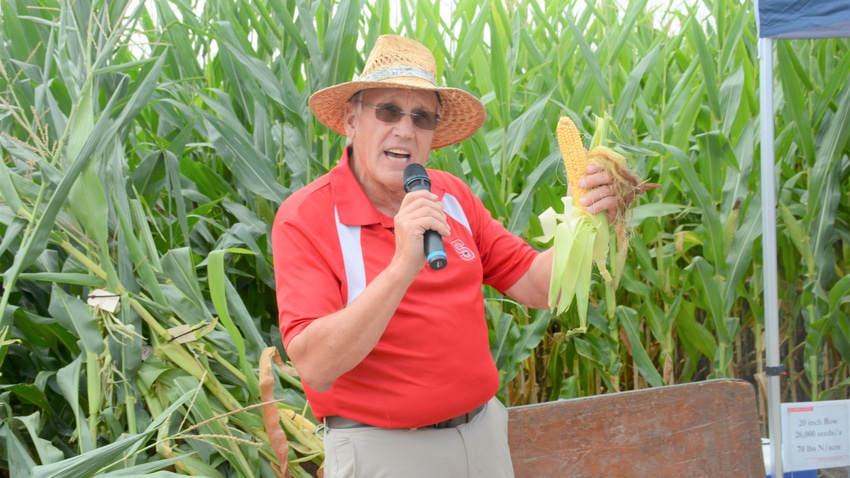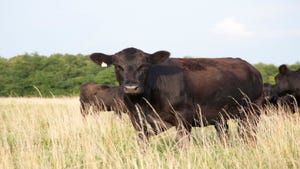
A common theme of Ron Heiniger’s guidance for achieving maximum corn yields is to do all you can to ensure uniform emergence. It’s a message he emphasized once again at this year’s Blackland Farm Managers Tour Aug. 2 at Middle Creek Farms in Engelhard, N.C.
The North Carolina State University Extension corn specialist stressed the importance of having enough nitrogen, water, and captured light to fill the corn out. He said it is critical to have nitrogen and water available all the way to the end to achieve maximum yields and increase kernel weight.
“We’re finding out more and more that kernel weight is one of the most important factors in high yield. We’ve been blessed in many places in this state with decent rainfall at just the right time, and our corn crop looks good. But how can we make this good corn into something great? It takes increasing kernel weight,” Heiniger said at the Blackland Tour.
Higher and drier findings
At the tour, Heiniger discussed research his team is conducting on a plot at Dawson Pugh’s Middle Creek Farms in Hyde County to ensure uniform emergence to maximize yields and increase kernel weight. The research is examining two row spacings, 20 inches and 30 inches; three plant populations, 26,000 plants per acre, 32,000 plants per acre, and 38,000 plants per acre; and four nitrogen rates, ranging from 70 units to 240 units per acre.
An interesting finding from the research shows that spots in the field where it was higher and drier showed quicker uniform emergence compared to spots in the plot that dipped down and showed slower, non-uniform emergence. Heiniger noted that plants in the plot where it dipped down and was wetter failed to emerge uniformly, grew poorly, and didn’t show as good pollination as plants in the rest of the plot.
As expected, plants in the 20-inch rows planted at 26,000 seeds per with the lower nitrogen rate of 70 pounds appeared punier than the other plants with the higher nitrogen rates, row spacings and plant populations.
Heiniger emphasized one key benefit of more uniform emergence is more abundant brace roots in the rooting system which leads to higher yields. He said a better root system helps the corn plant fill better and produce more kernels. He said quick, uniform emergence proves vital in setting root mass.
Root mass and row spacing
In their research, Heiniger and his team increased nitrogen rates as they increased seeding rates because “there were more mouths to feed,” as Heiniger puts it. With the 26,000 plants per acre population, they continued to see some yield increase with 230 units of nitrogen applied per acre. However, when they increased the seeding rate and applied just 130 units of nitrogen, that was enough nitrogen to maximize yields.
That surprised the researchers.
Heiniger said he and his colleagues had a tough time believing that 100 pounds less nitrogen would not harm yield. Interestingly, a similar study conducted by the Heiniger team on Dawson Pugh’s farm last year showed the same results.
Heiniger said he concluded that yields were maximized because they had more roots in the field.
“It’s not the number of plants you have, it’s how much root mass you have. The more roots you have out there, the more you explore soil. The more you find these nutrients attached to these colloids, the more fertilizer nutrients you take in, and the less nitrogen you need,” he said.
Heiniger said the research reveals that 38,000 plants per acre led to better nitrogen uptake than 26,000 plants per acre, just like the research last year showed. The increased population led to increased root mass to find that 130 pounds of nitrogen applied per acre.
Also, for the first time this year, Heiniger and his team are determining if row spacing makes a difference in maximizing corn yields in the Blacklands. “In the Blacklands, we tend to get better yields at higher seeding rates in narrow rows. Does that that translate into better nitrogen uptake in a narrow row?” Heiniger said.
It turns out that 38,000 seeds planted in 30-inch rows is not as good when it comes to nitrogen uptake, compared to 38,000 seeds planted in 20-inch rows. Heiniger said this shows that row spacing does indeed have an impact on nitrogen utilization.
“That’s important. When we talk about row spacing, we talk about seeding rate. You don’t want just to talk about yield, you want to think about how does a corn plant use nitrogen. How can I improve nitrogen utilization? Plant configuration makes a difference,” Heiniger stressed.
Exclusive to the Blacklands
Heiniger made it clear that these research results apply just to the North Carolina Blacklands, with its dark soil, rich in organic matter. The results will likely be different in different soil types in other regions of the state.
“I know what you’re thinking. You’re sitting here on Dawson Pugh’s farm. He’s got good water, he’s got good rainfall, he’s got a dark soil, he can go 38,000 without too much trouble. He might go 40,000 for that matter,” Heiniger said.
“But I’m in Sevren, N.C. on a doggone Norfolk sandy loam that didn’t get much rain this year, 38,000 would have burned up about five weeks ago. That’s too many plants. Furthermore, in Sevren, N.C., I got to plant some cotton and 20-inch rows don’t work for me, so for that farmer, what in the world is he going to do about taking up better nitrogen through configuration? He needs to bring the fertilizer to the roots, put it under the row, by the row,” Heiniger said.
In essence, Heiniger said the farmer who grows corn in sandy loam soil needs to concentrate their nutrients where those roots systems are going to be, rather than applying nitrogen all over.
About the Author(s)
You May Also Like






